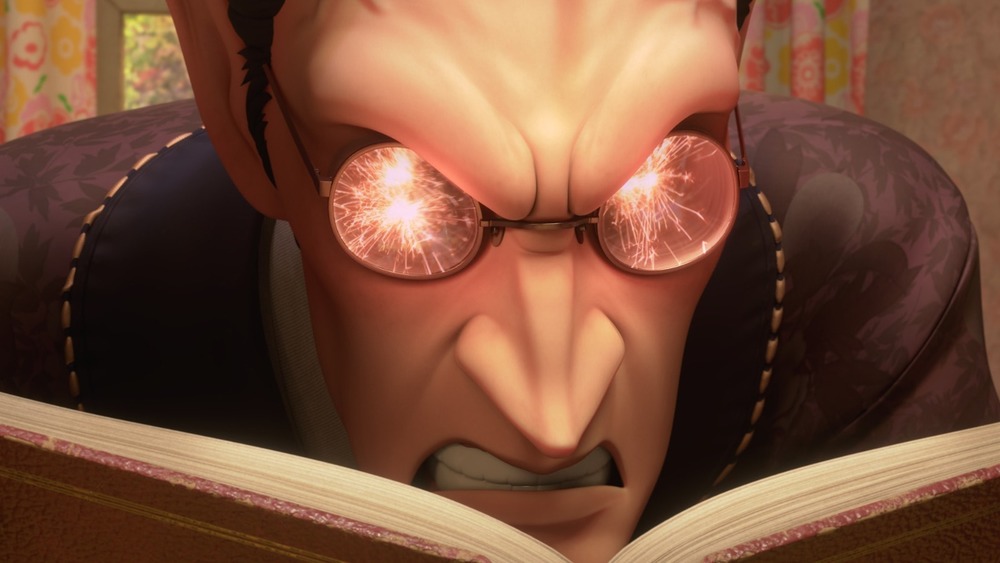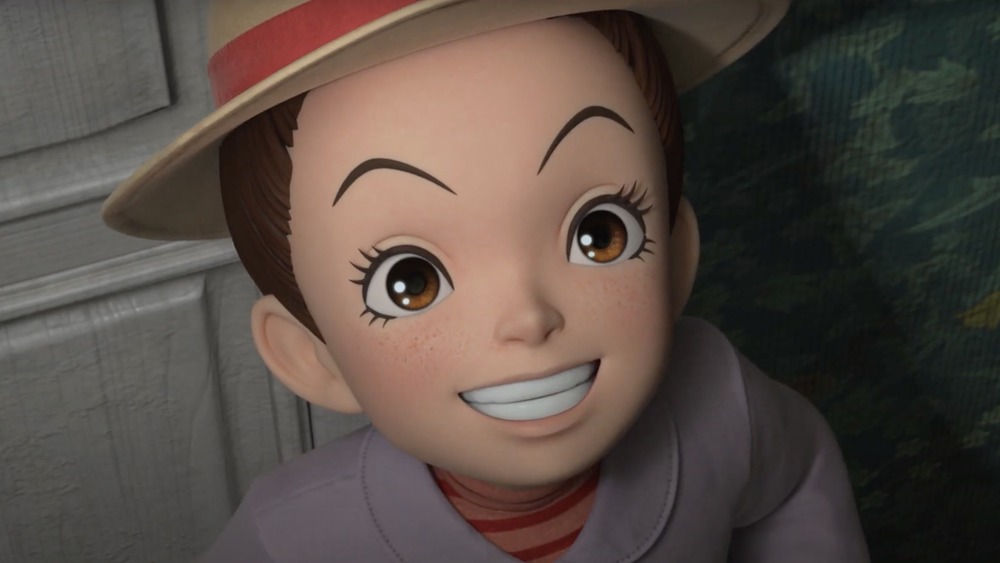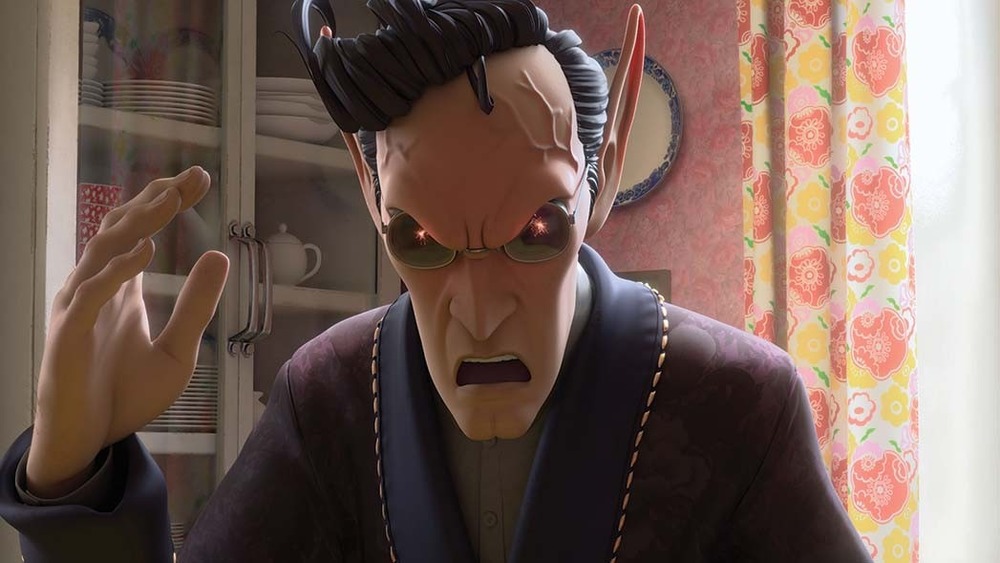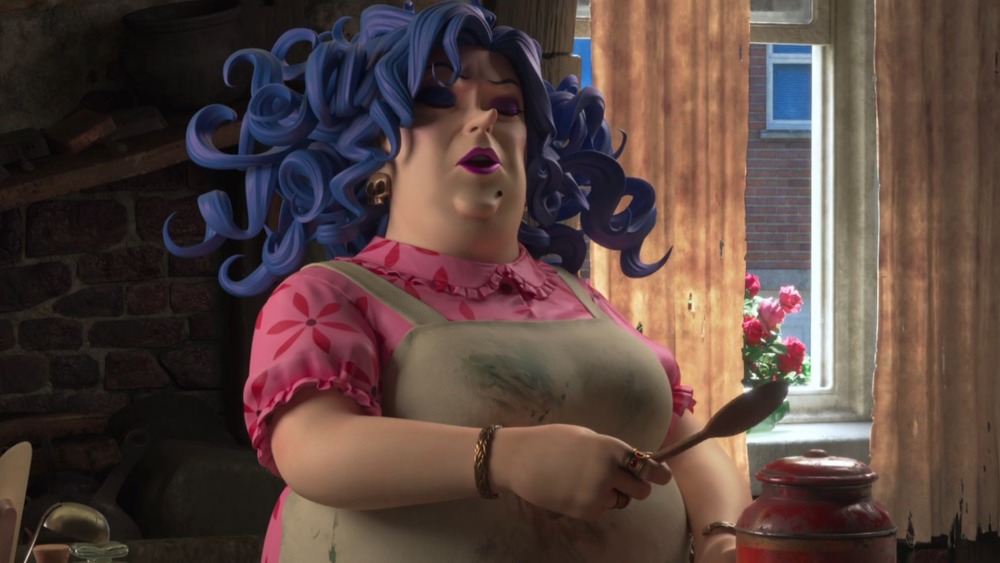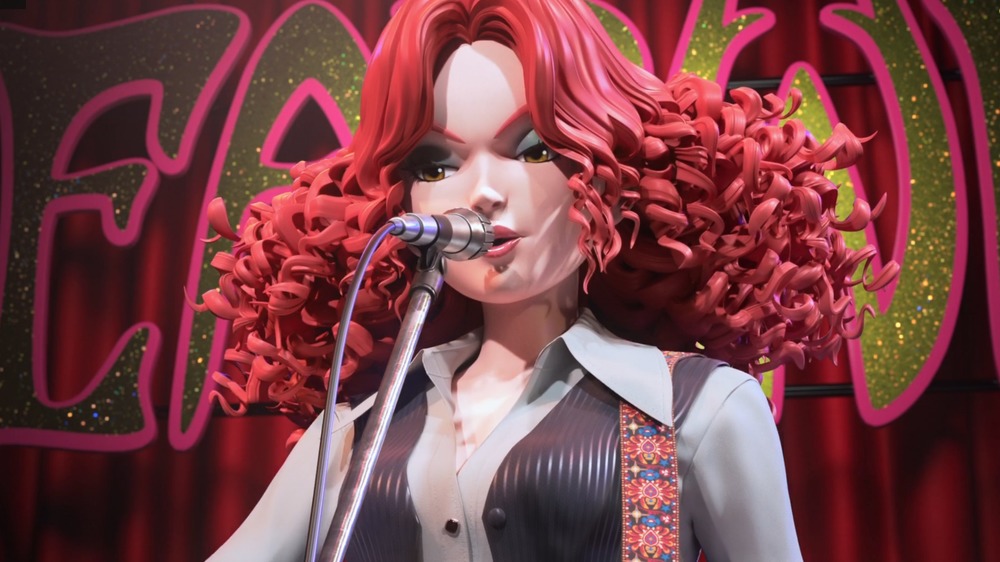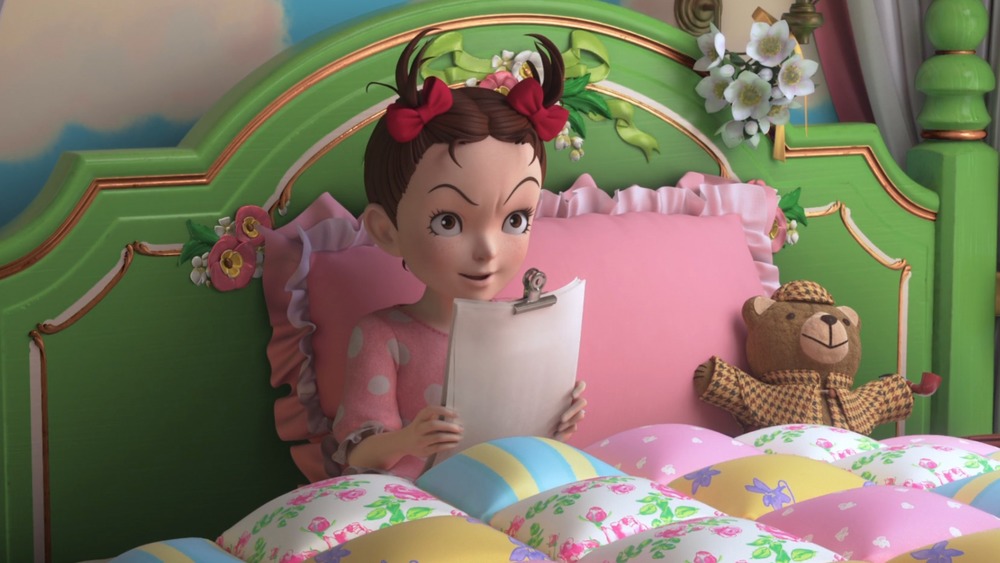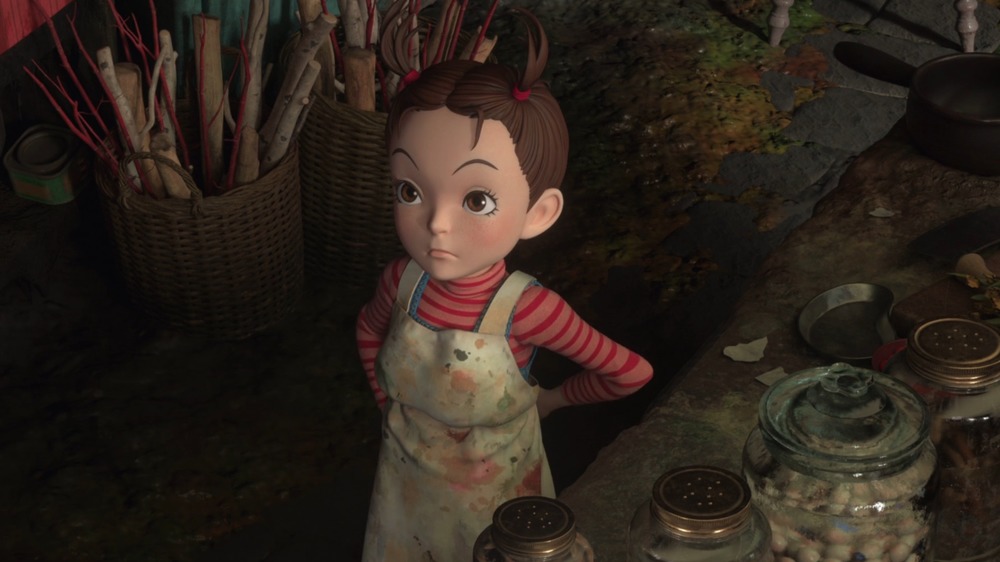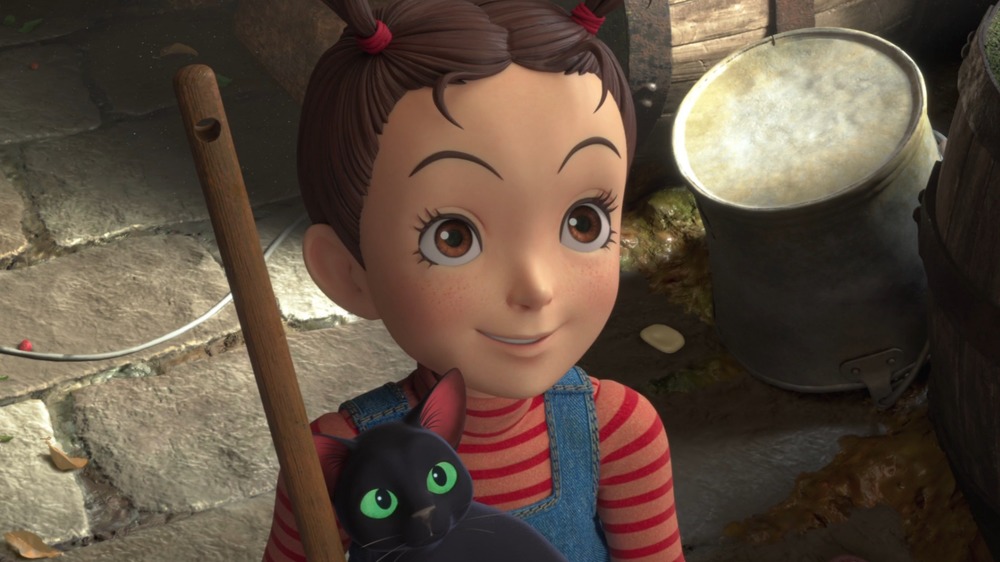The Ending Of Earwig And The Witch Explained
At first glance, Earwig and the Witch doesn't look anything like a Studio Ghibli film. The Japanese animation studio is best known for its gorgeous hand-drawn films that often delve into the fantastical — like Spirited Away or Princess Mononoke. The newest Ghibli film, however, immediately stands out from the rest: Earwig and the Witch is the studio's first computer-generated movie.
Gorô Miyazaki, the son of Ghibli co-founder Hayao Miyazaki, took his third round as a feature film director for Earwig and the Witch, basing it off of the English author Diana Wynne Jones' children's novel of the same name. Though Jones was a popular and influential writer in her own right, Ghibli fans will know her for authoring the book that inspired the beloved film Howl's Moving Castle.
Earwig and the Witch delves into a magical world of its own, beginning with a high-speed chase between a redheaded witch (voiced by singer Kacey Musgraves in the English version) and a ravenous yellow car. She drops her baby girl, Earwig, off at an orphanage for safe keeping, promising to come back when she no longer has 12 witches hunting her down. The girl, renamed Erica Wigg (Taylor Paige Henderson), grows up to be a manipulative young child who, despite her best efforts to the contrary, is adopted by the witch Bella Yaga (Vanessa Marshall) and the not-quite-human Mandrake (Richard E. Grant).
In her new home, a strange house with disappearing doors and rooms that exist in between dimensions, Bella Yaga puts Earwig to work preparing spell components. Earwig eagerly tries to get Bella Yaga to teach her magic, but becomes increasingly resentful when it's clear that she's expected to be a dutiful servant. With the aid of the talking cat Thomas (Dan Stevens) and through mischief and meddling, Earwig eventually gets Bella Yaga and the Mandrake under her thumb, turning a horrible living situation into a pleasant one. The final moment of the film shows her best friend from the orphanage, Custard (Logan Hannan), and, surprisingly, her mother coming for a visit.
It's a sudden ending, so let's break down what it really means.
Earwig manages to bend her adoptive parents to her will
Studio Ghibli films tend to have a young girl as their protagonist, but that simple description is where Earwig's similarities to her predecessors ends. Rather than being a gentle, honest girl, Earwig is a manipulative force of nature set on making everyone do exactly what she wants. At the orphanage, she has both the other children and the adults wrapped around her finger, showing no shame in playing the part of an overly sweet child to use them to her advantage. She's comfortable with this control and doesn't want to leave for a boring home with only a handful of people to do her bidding.
When Bella Yaga and the Mandrake adopt her, however, she finds the first real challenge to her usual wiles. She's excited to learn magic, but dismayed by Bella Yaga's disinterest in teaching her. Still, Earwig doesn't lose hope or feel beaten down by their unwelcoming demeanor. Eventually, she brings the curmudgeonly Mandrake onto her side by showing interest in his novel writing and lavishing him with compliments.
The movie ends with Earwig having manipulated the uncomfortable situation to her benefit. She's back where she started, though now with two magical adults bending to her will as opposed to those working at the orphanage. While Earwig is in for a surprise when her mother shows up at the door, the film ends before she can learn of her parentage.
The Mandrake gains a friend (who hopefully won't abandon him this time)
Throughout Earwig and the Witch, the vaguely demonic Mandrake holds power as a mysterious threat to both Earwig and Bella Yaga. Above all, he doesn't want to be disturbed. Over the smallest slights, the Mandrake becomes enraged with burning eyes, but Earwig isn't intimidated. Though Mandrake shows little interest in her at first, Earwig uncovers his passion for writing and playing music — and the root of the discontentment permeating through the house. Through flashbacks, we learn that before Earwig was born, the Mandrake was in a band with Bella Yaga and Earwig's mother. It's hinted that he and the redheaded witch were in love, or at least on the verge of a romantic relationship, but her exit from their lives drove a wedge between him and Bella Yaga.
Earwig's crafty remarks about the Mandrake's creative works and use of exuberant compliments soften him by the end of the film. He's wistful for the old days of their band and feels abandoned by Earwig's mother. However, Earwig insists she won't leave him, and so he agrees to make Bella Yaga teach her magic. In the end, the Mandrake is no longer the creepy unknown threat, but something roughly resembling a father figure. At the core of it, he's simply an artist who doesn't want to be disturbed as he tries to recreate the magic of the past.
Bella Yaga slowly begins to heal from the past
As the unpleasant witch who immediately puts Earwig to work on grinding up rat bones, Bella Yaga is a clear reference to the Russian fairy tale Baba Yaga. Both of them force children to do their chores, though thankfully, Bella Yaga never goes so far as to eat Earwig. She treats Earwig as a servant, but Bella Yaga actually acts under the rules of the Mandrake. He holds power over her, which is how she winds up finally agreeing to teach Earwig magic by the end of the film.
That said, Bella Yaga is just as marred by the past as the Mandrake is. In the end, a little life comes back into her when she hears that the Mandrake complimented her skills as both a drummer and a witch. It's clear that the redhead's exit from the band caused a deep rift between Bella Yaga and the Mandrake, but with Earwig's selfish meddling, it's beginning to heal. The windows are now open — the house is no longer suffocating — and the three of them are a weird, but functioning, family.
Earwig's mother escapes the 12 witches
It's the unnamed redheaded mother who opens and closes Earwig and the Witch. She stars off by running away from her coven of witches, but ends by returning to her daughter. Through flashbacks, it's revealed that she was the singer of the band Earwig, but left them and the coven when she struck out on her own. Much like her daughter, the redheaded witch didn't want to be told what to do, so she sought independence. When she drops Earwig off at the orphanage, she leaves a note saying that she'll be back once she escapes the witches coming after her.
Apparently, she finally achieves this goal, though Earwig and the Witch never says how. In the last scene, she shows up to the house for Christmas dinner with Earwig, Bella Yaga, and the Mandrake. What comes after is left open-ended, but there must be either reconciliation or confrontation between her and her old bandmates.
The ending of Earwig and the Wig begs an important question: Does she take Earwig away to live somewhere else? It's hard to imagine the pair of them living together, as Earwig is insistent on telling people what to do and her mother wants nothing more than to do her own thing. Perhaps everyone will be content to let Earwig live with Bella Yaga and the Mandrake, but first, the old bandmates would need to hash out their issues together.
The precocious young Earwig makes this story unique
As a children's movie, Earwig and the Witch doesn't have a particularly poignant moral, as it's more interested in exploring the antics of an unusual little girl. Director Gorô Miyazaki told The Verge that Earwig's character is what stood out to him, as she's totally unlike a common film archetype. He said, "When it's necessary, she can be manipulative of people around her, and when somebody treats her bad, she thinks of how she can get back at them. It's not your typical heroine from a lot of Japanese animation where they're very honest, pure, and beautiful." Earwig doesn't passively wait for others to rescue her; she takes it upon herself to change the situation.
In an interview with The Los Angeles Times, Gorô Miyazaki explained that he "wanted to portray [Earwig] as someone who is energetic and honest about her wants who just doesn't fit the 'good kid' mold." He added that it makes her charming.
It's definitely unusual to see a conniving young child as the protagonist of a film — particularly an animated children's one. Though she turns their mess of a household into a family, it's hard not to pity Custard for being stuck with Earwig as his best friend.
Why did Studio Ghibli animate Earwig and the Witch in 3D CG?
To say nothing of the story, Earwig and the Witch immediately stands out because it's the first 3D CG film made by Studio Ghibli. They've previously animated in CG for Gorô Miyazaki's series Ronja, the Robber's Daughter, but this film is something completely new. Visually, though there's an echo of the classic Ghibli art style, especially in Earwig's features and the giant hair of the redheaded woman, it's a far cry from the studio's iconic films. So why did the studio depart from its usual fare? Gorô Miyazaki told The Verge that hand-drawn animation has its limits.
"One of the things I found was that with hand-drawn animation, you have to rely on the hands of a very talented animator to bring out a great performance from the character with facial expressions, emotions, and so forth. There's a limited number of very talented animators that can do so," he said. "But with 3D CG, you're able to have different people working on different expressions of one character, which worked well for us."
Not only that, but Gorô Miyazaki also said CG made it easier to animate the extremely detailed sets and backgrounds of the house. He took inspiration from both stop-motion animation and Ghibli's iconic style to create Earwig and the Witch's unique look.
What does this mean for future Ghibli films?
Despite Earwig and the Witch's obvious departure from classic Studio Ghibli features, Gorô Miyazaki did try to bring the essence of the studio's films to this one. One element in particular was important to him. As he told The Los Angeles Times, "Ghibli films are known for their scenes involving food and cooking and eating. I don't think there are a lot of CG works that are as serious in their depiction of food, so that was one of the areas I really focused on getting right."
By no means does Earwig and the Witch prove that all Studio Ghibli films should be animated in CG from here on out. Instead, it opens up a new niche in the genre: Earwig skews younger, while other Ghibli films are often enjoyed by adults and children alike. "Children aren't concerned about whether something is 3D CG or cel animation," Gorô Miyazaki noted to The Los Angeles Times. Older Ghibli fans might be more pleased with Hayao Miyazaki's upcoming (and hand-drawn) film How Do You Live?, but the industry shift to using more frames per second has drastically lengthened the production for those kinds of films (via Entertainment Weekly).
Earwig and the Witch probably won't make it near the top ranking of Ghibli films, but there's always something to be said for experimentation. It's impossible to say just yet if 3D CG will take off in Japanese animation: Despite its advantages over the traditional method, it has yet to recreate the magic of the lovingly drawn films that made Studio Ghibli internationally adored.
